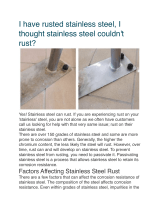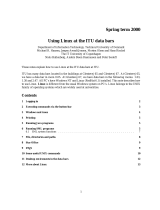
R03.001_02/06/2010
TECHNICAL FILE
STAINLESS STEEL
Stainless steel is an alloy which contains, minimum, from 10.5 to 11% of Chrome
in its composition. This element forms a passivating layer on the surface of
stainless steel and makes it highly resistant. The stainless steel used in Emac®
products is AISI-304, an austenitic steel which belongs to 300 series, with IIID
surface (high brightness) and a foil resistant to UV. This stainless steel has an
excellent corrosion resistance, excellent hygiene and cleaning factor, easy
transformation, excellent weldability and can be used in a wide temperature
range satisfactorily.
Technical Features
Applications
Stainless steel is a high resistant material against corrosion wich, with the rest of its properties, makes
their applications nearly innite. We can nd the stainless steel in homes (for example: kitchenware,
ovens, garden equipment, furniture), in the city (phone boxes, street furniture, elevators, infrastructu-
res) or in industry (automotive parts, chemical plants, water treatment plants) etc.
Due to its excellent properties and its unsurpassable aesthetic appearance, Emac® offers options
made in stainless steel in all of its families of product, from those who have a decorative function (such
as listellos) to the most functional (such as expansion joints or stair nosing).
The stainless steel of Emac®’s products is highly durable and it stands in optimal conditions while are
followed the installation and cleaning instructions indicated for each case. The posterior maintenance
is also important. The stainless steel of Emac®’s products is available in different nishes which allow
multiple decorative possibilities.
Page 1 of 3
Mechanical
Elongation (%) < 60
Brinell hardness 160-190
Izod impact (J*m
-1
) 20-136
Elastic modulus (MPa) 190-210
Tensile strenght (MPa) 460-1100
Corrosion resistance
Saline mist test
UNE 112017:92
+ 504 hours without change (s.steel)
+ 650 hours without change (s.steel with
titanium)
Physical
Density 7,93 g*cm
-3
Thermal
Thermal expansion coef-
cient (10
-6
*K
-1
)
18
Thermal conductivity at
73,4ºF / 23ºC
16,3

R03.001_02/06/2010
TECHNICAL FILE
STAINLESS STEEL
Cleaning
Maintenance
Finishes of stainless steel used in Emac®
It’s essential the immediate cleaning of the material after its installation to avoid that the mortar
remaining, concrete or the iron particles from scourers or tools can cause pitting corrosion.
For outdoor applications such as facades, the rainfall is an efcient cleaner. Pay special attention to
areas of difcult access and be sure you remove all the dust and other elements remainings. You can
do this cleaning once per month.
For indoor applications, you can use water with dishwashing detergent, liquid soap or similar to remove
dirtiness and the possible ngerprints marked on the surface of the prole. In high brightness nishes
you can use a glass cleaner. There are special cleaners for stainless steel in the market that clean
the material and reduce the appearance of possible stains. Whenever you clean the stainless steel,
remember rinsing well and drying totally to prevent fogging.
Steel wool or similar products are not recommended because they could scratch the surface and
cause pitting corrosion. Pay special attention with the use of materials containing chlorides. Those
materials are contraindicated because they oxidize the material. The hydrochloric acid or iron products
in prolonged contact with the prole, are not recommended. Do not use common steel cleaners for the
cleaning of stainless steel.
- Dust and dirtiness: clean with water and/or detergent. You can use pressure water or steam.
- Inclusions of iron particles: Use an appropriate cutting tool to guarantee the better conservation
of the prole. If the prole is damaged, treat the surface with nitric acid 20% and then rinse and dry.
Check the result with the ferroxilo test. If the treatment does not work, apply a solution of nitric acid
and hydrouoric one.
- Mortar and concrete remainings: Clean the surface with a specic remover diluted in a small quantity.
Then, rinse and dry the prole.
- Oxidized areas: Clean well the surface, let it dry and after treat it with a solution of nitric acid 20% for
20 minutes. Depending on the oxidation degree and the time it has been oxidized, the recovering will
be total or partial.
- Oil and grease: Remove these stains with solvents based alcohol or alkaline cleaners and rinse with
plenty of neutral water. Be careful with these products, since they can spread the stains and make
difcult their elimination.
The stainless steel products of Emac® are available in two basic nishes: high brightness and brushed,
as well as in four special nishes belonging to Futura range.
- High brightness: Unbeatable nish high brightness with a slightly porous and smooth surface
which allows its cleaning. All the Emac® products made in stainless steel are IIID surface except
Novopeldaño® 4 which is IIR.
- Brushed: Finish matte one-way, not reector, excellent for public areas or indoors because doesn’t
leave ngerprints on the surface.
- Futura range: Finishes available in brushed titanium, bright titanium, oxide brushed and bright oxide.
These nishes are made with a cover containing titanium. This covering, increase the supercial
hardness, the corrosion resistance and provides a brightness and color very attractive.
Page 2 of 3

TECHNICAL FILE
You can amplify information about the technical features of Emac®’s products by downloading their
Technical File from www.emac.es.
If you have any query please contact our Technical Department in [email protected]
Technical information
R03.001_02/06/2010
Emac Complementos S.L. (Spain) info@emac.es // Emac America L.L.C. (FL,USA) [email protected] // Emac Italia S.R.L. (Italy) [email protected]
www.emac.es
The data provided are for information only and have been obtained by our supplier or Emac®.
Does not constitute legal guarantee in terms of properties and / or functionality of the application of material
STAINLESS STEEL
Links
- www.wikipedia.org
- www.goodfellow.com
- www.euro-inox.org
- www.emac.es
Page 3 of 3
- Adhesives remainings: Remove them by using solvents.
- Paint, chalk, crayon: Clean with water or alkaline cleaners. For paint stains, you can use solvents with
the same base than the paint. Do not use abrasive tools.
*The results from the application of these techniques will depend on the degree affectation of the material and the time elapsed
since its exposition.
-
 1
1
-
 2
2
-
 3
3
Ask a question and I''ll find the answer in the document
Finding information in a document is now easier with AI
Related papers
-
Emac NPA13 User manual
-
Emac NPERI11012 User manual
-
Emac NR9AL13 Installation guide
-
Emac NEA1334 Installation guide
-
Emac NS4M120A Installation guide
-
Emac NVAF1312 Installation guide
-
Emac NVX8812 Installation guide
-
Emac ND14838 Installation guide
-
Emac NP41312 User manual
-
Emac NGRIPVNE Installation guide
Other documents
-
 Hampton Bay HPS-C-PC FAQ
Hampton Bay HPS-C-PC FAQ
-
Apple eMac User manual
-
 Spring Switzerland GmbH 2000 User manual
Spring Switzerland GmbH 2000 User manual
-
Xilinx Virtex-4 RocketIO User manual
-
Texas Instruments TMS320TCI6486 User manual
-
Texas Instruments TMS320DM36X User manual
-
Texas Instruments EMAC Implementation for the TMS320C6472/TMS320TCI6486 (Rev. A) Application notes
-
Mackie CFX SERIES User manual
-
Texas Instruments TMS320C6474 DSP EMAC/MDIO Module Reference (Rev. B) User guide
-
Walter Surfox 203 User manual




